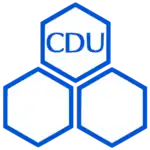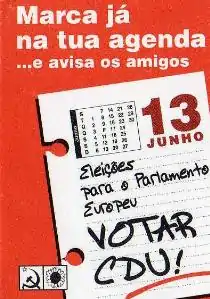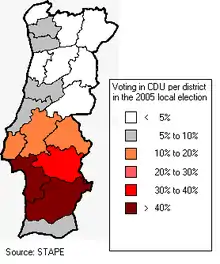Unitary Democratic Coalition Coligação Democrática Unitária | |
|---|---|
 | |
| Abbreviation |
|
| Leader | Paulo Raimundo |
| Founded | 1987 |
| Preceded by | United People Alliance |
| Headquarters | Rua Soeiro Pereira Gomes 3, 1600-019 Lisboa |
| Youth wing | Juventude CDU |
| Membership | 49,960 in 2020 (PCP) c. 6,000 in 2007 (PEV) |
| Ideology | Communism[1][2] Eco-socialism[3] Hard Euroscepticism[4][5] |
| Political position | Left-wing to far-left |
| European Parliament group | |
| Colours |
|
| Member parties | |
| Assembly of the Republic | 6 / 230 |
| European Parliament | 2 / 21 |
| Regional Parliaments | 1 / 104 |
| Local government (Mayors) | 19 / 308 |
| Local government (Parishes) | 112 / 3,058 |
| Election symbol | |
| Website | |
| www | |
The Unitary Democratic Coalition[6] (Portuguese: CDU – Coligação Democrática Unitária, CDU) is an electoral and political coalition between the Portuguese Communist Party (Portuguese: Partido Comunista Português or PCP) and the Ecologist Party "The Greens" (Portuguese: Partido Ecologista "Os Verdes" or PEV). The coalition also integrates the political movement Democratic Intervention (Portuguese: Intervenção Democrática or ID).
The coalition was formed for the first time in 1987 in order to run to the simultaneous legislative election and European Parliament election that were held on July 19 of that year.
Since the beginning of the coalition, the member parties have never participated separately in any election. The Communist Party is the major force inside it and has the majority of places in the electoral lists, however, the Greens also have an important presence, for instance, electing 2 members of parliament among the 17 elected by the coalition in the 2015 legislative election. Each party has its own parliamentary group and counts as a separate party in official issues. In the 2022 Portuguese legislative election, the Greens failed to elect any representatives.
At a local level, the coalition usually presents lists in almost every municipality and both Communists and Greens may occupy first place on the lists. As the Greens have a smaller structure, the offices of the Communist Party are used as offices of the coalition.
The coalition supported the minority Socialist Costa Government (2015–2019) with a confidence and supply agreement.
Symbol
The present symbol of CDU shows the PCP's symbol and the PEV's symbol, a hammer and sickle and a sunflower, respectively, with the respective names below. That symbol replaced a former one that featured three hexagons with the inscription: CDU and was often used with a beehive. That was sometimes said to mean that CDU worked just like a bee (collectively and every day) and the hexagons were meant to represent the cell-based Leninist organization of the PCP.
 Coalition logo in 1987.
Coalition logo in 1987. Current logo of the coalition.
Current logo of the coalition.
Youth organization
The coalition has a youth wing, called Juventude CDU, that develops political work in youth related subjects, along with youth-oriented activities, mainly during the electoral campaigns. The Juventude CDU is mainly composed by members of the youth wings of the parties that compose the CDU, the Portuguese Communist Youth and the Ecolojovem.
Electoral results achieved by CDU
Assembly of the Republic


Vote share in the Portuguese legislative elections
| Election | Leader | Votes | % | Seats | +/- | Government |
|---|---|---|---|---|---|---|
| 1987 | Álvaro Cunhal | 689,137 | 12.1 (#3) | 31 / 250 |
Opposition | |
| 1991 | 504,583 | 8.8 (#3) | 17 / 230 |
Opposition | ||
| 1995 | Carlos Carvalhas | 506,157 | 8.6 (#4) | 15 / 230 |
Opposition | |
| 1999 | 487,058 | 9.0 (#3) | 17 / 230 |
Opposition | ||
| 2002 | 379,870 | 6.9 (#4) | 12 / 230 |
Opposition | ||
| 2005 | Jerónimo de Sousa | 433,369 | 7.5 (#3) | 14 / 230 |
Opposition | |
| 2009 | 446,279 | 7.9 (#5) | 15 / 230 |
Opposition | ||
| 2011 | 441,147 | 7.9 (#4) | 16 / 230 |
Opposition | ||
| 2015 | 445,901 | 8.3 (#4) | 17 / 230 |
Opposition (2015) | ||
| Confidence and supply | ||||||
| 2019 | 332,018 | 6.3 (#4) | 12 / 230 |
Opposition | ||
| 2022 | 238,920 | 4.3 (#6) | 6 / 230 |
Opposition |
European Parliament
| Election | Leader | Votes | % | Seats | +/- |
|---|---|---|---|---|---|
| 1987 | Ângelo Veloso | 648,700 | 11.5 (#4) | 3 / 24 | |
| 1989 | Carlos Carvalhas | 597,759 | 14.4 (#3) | 4 / 24 |
|
| 1994 | Luis Manuel de Sá | 340,725 | 11.2 (#4) | 3 / 25 |
|
| 1999 | Ilda Figueiredo | 357,671 | 10.3 (#3) | 2 / 25 |
|
| 2004 | 309,401 | 9.1 (#3) | 2 / 24 |
||
| 2009 | 379,787 | 10.6 (#4) | 2 / 22 |
||
| 2014 | João Ferreira | 416,925 | 12.7 (#3) | 3 / 21 |
|
| 2019 | 228,157 | 6.9 (#4) | 2 / 21 |
Regional Assemblies
| Region | Election | Leader | Votes | % | Seats | +/- | Government |
|---|---|---|---|---|---|---|---|
| Azores | 2020 | João Corvelo | 1,741 | 1.7 (#9) | 0 / 57 |
No seats | |
| Madeira | 2023 | Edgar Silva | 3,677 | 2.7 (#5) | 1 / 47 |
Opposition |
Local elections
| Election | Leader | Votes | % | Councillors | +/- | Mayors | +/- |
|---|---|---|---|---|---|---|---|
| 1989 | Álvaro Cunhal | 633,682 | 12.8 (#3) | 253 / 1,997 |
50 / 305 | ||
| 1993 | Carlos Carvalhas | 689,928 | 12.8 (#3) | 246 / 2,015 |
49 / 305 |
||
| 1997 | 643,956 | 12.0 (#3) | 236 / 2,021 |
41 / 305 |
|||
| 2001 | 557,481 | 10.6 (#3) | 202 / 2,044 |
28 / 308 |
|||
| 2005 | Jerónimo de Sousa | 590,598 | 11.0 (#3) | 203 / 2,046 |
32 / 308 |
||
| 2009 | 537,329 | 9.7 (#3) | 174 / 2,078 |
28 / 308 |
|||
| 2013 | 552,506 | 11.1 (#3) | 213 / 2,086 |
34 / 308 |
|||
| 2017 | 489,189 | 9.5 (#3) | 171 / 2,074 |
24 / 308 |
|||
| 2021 | 410,666 | 8.2 (#3) | 148 / 2,064 |
19 / 308 |
Notes
- ↑ since 2022
References
- ↑ THE STATE OF POPULISM IN EUROPE (2016) via Politico EU
- ↑ The State of Populism in Europe 2017 via Academia
- ↑ Nordsieck, Wolfram (2019). "Portugal". Parties and Elections in Europe.
- ↑ Godinho, Luísa (2019). "The local construction of Euroscepticism: a downsian approach to the positioning of the Portuguese Communist Party vis-à-vis the European project". Centro de Estudos Internacionais (CEI-ISCTE).
- ↑ "Europeias: CDU defende "outro projeto" europeu, PS alerta que ideia "é muito perigosa"" (in Portuguese). Diário de Notícias. 7 May 2019.
- ↑ "Elections for the National Parliament, 4th October 2015". 28 September 2015.